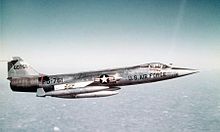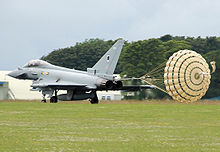North American Eagle Project
The North American Eagle Project Supersonic Speed Challenger (German: 'supersonic challenger') was a jet-powered test vehicle that was supposed to break the speed record of 1,228 km / h ( Mach 1.02) set by the ThrustSSC in 1997 . The project was a collaboration between Canadian and US engineers, pilots and mechanics who were determined to bring the record back to the US from the UK . In 2013, a first attempt was made to break the sound barrier and reach 1287 km / h or Mach 1.058.
The North American Eagle set the absolute land speed record for women as well as the land speed record in four-wheeled vehicles.
Another record attempt by the “North American Eagle” resulted in a serious accident on August 27, 2019, in which the pilot Jessi Combs was killed. The future of the project is unclear (as of July 2020).
description
The vehicle was based on the fuselage of a Starfighter Lockheed F-104 A-10 fighter aircraft with the tail number 56-0763. The aircraft was built for the U.S. Air Force and assigned to the Air Force Flight Test Center at Edwards Air Force Base. The jet was in use there from August 29, 1957 until it was retired in 1970. The aircraft was initially used by General Electric as a test platform for the J79 engine. Later it was used as a chase or escort aircraft for the test programs North American X-15 , Lockheed SR-71 "Blackbird" and North American XB-70 "Valkyrie". The jet has been flown by famous pilots such as Joe Walker , Scott Crossfield , Pete Knight , Bill Dana , Chuck Yeager , Joe Engle and Bob Gilliland , among others .
For use as a record-breaking vehicle, the North American Eagle Project designed the assemblies for the suspension of the (non-driven) wheels and carried out the necessary system integration. The vehicle was 17.1 m long and weighed 5900 kg.
Engine
As drive a General Electric LM1500 turbine turbojet came (a civilian version of the originally installed in the airplane General Electric J79 -Triebwerks) are used. A production engine that was used for low speed tests produced 42,500 hp (31.7 MW ). For the record attempts, the vehicle was equipped with an improved engine with 52,000 PS (38.2 MW) output.
When idling, the production engine consumes 40 US gallons (151 liters) of fuel per minute. The military version of the unit (J79) requires 80 US gallons (303 liters) per minute at 100% thrust. In afterburner mode, consumption increases to 90 US gallons (341 liters).
Chassis / wheels
Since the NaE is not driven by wheels and is only intended for straight-line travel , the driving dynamics do not play a major role in the construction of the chassis .
Only the front axle received a gas pressure damper system to absorb impacts. The rear suspension consists of a rectangular frame built from rectangular steel tubes. It runs backwards in a delta or triangle configuration. This frame is made of mild steel (or low carbon steel) which is cheap, strong, and easy to shape.
The vehicle moves on five wheels: one at the front for steering, two side by side on an offset central axis and two at the rear. For slow (test) drives below 350 miles per hour (563.27 km / h) the wheels are equipped with rubber tires. For high-speed travel (up to 800 miles per hour / 1287.48 km / h) the standard aircraft wheels are removed and replaced by solid billet aluminum wheels (milled from solid) with a titanium band on the outer tread of the wheel for a higher one To achieve strength and tension maintenance.
cockpit
The cockpit of the North American Eagle is still very similar to that of the underlying F-104. It picks up the driver, who is buckled up with an extra wide five-point seat belt. Instead of a steering wheel, the driver will find the original control stick of the starfighter. A hydraulic system transfers the pilot's steering movements to the front wheel so that the car can be steered (to a limited extent) to the right or left. A very simple instrument panel with temperature gauges, fuel and oil pressure gauges, air speed gauge and Mach gauge is placed just behind the control stick. Using a radio, the driver can communicate with members of his crew and other support staff on the track who will help monitor the condition of the dry lake surface and other variables that may affect the outcome of the race.
Braking systems
As of 2014, four different systems were used to brake the vehicle: First there were high-speed air brakes , which were adopted from the original equipment of the F-104, from a speed of around 700 mph (1100 km / h), high-speed brake screens slowed down the journey assisted by low speed drag screens at below 350 mph (560 km / h). The vehicle was also equipped with a non- blocking neodymium rare earth magnet - eddy current brake. Brake failure or a break in the front suspension are believed to be the cause of the North American Eagle's accident during the record attempt in August 2019.
history
From June 2004 a total of 14 engine test runs were carried out on a test bench , the last two tests at full power and with the afterburner switched on . The first tests with the vehicle took place in December 2004. Between March 2006 and June 2008 a total of 23 additional test runs with the North American Eagle were completed. Speeds of up to 640 km / h (397.6 miles per hour) were reported, but not verified by external official authorities for speed records of motor vehicles. Further tests took place in the USA, among other places, at Sanderson Field in Shelton (Washington) . This was followed by test runs at Toledo Airport in southwest Washington State , Edwards Air Force Base and El Mirage Dry Lake in California, and in the Black Rock Desert , Nevada .
On October 9, 2013 Jessi Combs launched the North American Eagle (NAE) Supersonic Speed Challenger in the Alvord Desert (Oregon), a series of experiments to the "Women's 4-wheel country speed record" (4-wheel land speed record for women) to attack. During one of those "sessions" she broke the 1965 record of Lee Breedlove ( Craig's wife) in an official run at a confirmed average speed of 632.4 km / h (392.9 mph) over the distance of one mile Breedlove ) in the Spirit of America - Sonic 1 at 496.5 km / h (308.5 mph).
On September 7, 2016, Combs allegedly set a new top speed record of 477.59 mph (768.61 km / h) with a vehicle called the American Eagle . The statements on this are contradictory.
accident
On August 27, 2019, an accident occurred in the Alvord Desert (Oregon) while attempting to record a speed record with the North American Eagle , in which the driver Jessi Combs was killed. According to reports, the car could not be stopped and drove over the edge of the dry lake bed. The results of the investigations into the cause of the accident were published in November 2019. These investigations revealed that the assembly that made up the front suspension of the vehicle had broken - probably as a result of collision damage caused by impact with an unspecified object on the route. Combs died from the effects of blunt violence in the head area and was already dead when their vehicle went up in flames.
In late June 2020, the Guinness Book of Records reclassified the August 27, 2019 record attempts as sufficient to meet their requirements, and Combs was credited with a record speed of 841.338 km / h (522.783 mph), breaking the record after 40 years.
Similar vehicles
See also
Web links
- North American Eagle Project
- The North American Eagle Extensive report. On YouTube . Retrieved July 28, 2020 (en)
- KGW News News article on the fatal accident. On YouTube . Retrieved July 28, 2020 (en)
- Spiegel.de “America is looking for the super laser” (2008). Retrieved on July 28, 2020 (de)
Individual evidence
- ^ A b c d William Harris: How the North American Eagle Works. In: HowStuffWorks. May 3, 2007, p. 1 , accessed on August 27, 2020 (English).
- ↑ Jessi Combs: US racing driver given female speed record in 2019 fatal crash on bbc.com, accessed June 29, 2020
- ↑ a b 'Fastest Woman On Four Wheels' Jessi Combs Killed In Jet-Car Crash. In: Jalopnik. Gizmodo Media Group , August 28, 2019, archived from the original on September 14, 2019 ; accessed on September 18, 2019 .
- ^ Aviation Data. In: Airport-data.com. Archived from the original on October 4, 2013 ; Retrieved October 2, 2013 .
- ↑ Crossfield flowing 56-0763. Archived from the original on October 4, 2013 ; Retrieved October 2, 2013 .
- ^ Vehicle Information. In: North American Eagle. Archived from the original on March 7, 2016 ; accessed on August 27, 2020 .
- ^ William Harris: How the North American Eagle Works. May 3, 2007, p. 2 , accessed on August 27, 2020 (English).
- ↑ a b Jessi Combs death investigation: Cause of 550-mph crash in Alvord Desert determined. Retrieved November 11, 2019 .
- ↑ a b Jessi Combs' Jet-Car Crashed After Failing To Stop, Traveling Beyond Edge Of Lake Bed. August 28, 2019, archived from the original on August 28, 2019 ; accessed on September 18, 2019 .
- ↑ Geomagic. Archived from the original on October 4, 2013 ; Retrieved October 2, 2013 .
- ^ Angus MacKenzie: Jessi Combs breaks 48-year old land speed record. October 15, 2013, accessed August 27, 2020 .
- ↑ Jessi Combs: Video of land-speed record attempt ... Led To Fatal Crash. September 4, 2019, archived from the original on September 16, 2019 ; accessed on September 19, 2019 .
- ↑ Cause of Jessi Combs fatal crash released on roadandtrack.com, accessed November 22, 2019
- ↑ Jessi Combs fatal jet car crash was caused by front wheel failure on dailymail.co.uk, accessed November 22, 2019
- ↑ American jet-car racer and Mythbusters host Jessi Combs posthumously awarded world land-speed record for a woman. In: ABC / AP . June 25, 2020, accessed on August 27, 2020 .




